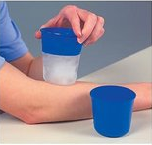It can be confusing to know when to use ice or heat for pain and injury. Most doctors and professionals recommend ice and rarely recommend heat. Ice and heat can be very effective and cost effective ways to treat your own minor injuries and pain.
Ice and heat can also be used not just for pain but as a means to prevent pain. They both have physiological effects on your tissues. This is different than products like icy hot where it just numbs pain. Products like Icy Hot are skin irritants and take your brains’ focus off of the pain. While there is nothing wrong with stopping pain with these products they do little to heal. Ice and heat have healing effects on your tissues.
As there isn’t an absolute measure to know when ice or heat should be used, if one doesn’t feel right or makes you feel worse, switch.
Here are some guidelines on when you should use ice or heat.
Acute Inflammation vs. Chronic Inflammation
Inflammation is a normal and necessary response to injury. Your body sends white blood cells to the site of injury with the intent of cleaning the area from infection and to rebuild damaged tissue.
There are two different groups of white blood cells for this purpose. The white blood cells that clean the area are only present for the first twenty four to seventy two hours. After that they leave.
After the first seventy two hours the white blood cells that rebuild tissue will be there until the area is completely healed.
It is not recommended to use heat on acute inflammation. It will make it worse. Conversely, it is not recommended to use ice on chronic inflammation or pain that is associated with areas that have decreased local blood circulation like tight muscles or trigger points. Ice will generally make that pain worse.
For Acute Inflammation Use Ice
Generally, when you first injure yourself or there is a specific trauma, like banging your shin on a coffee table, you want to use ice. This will mainly help with pain from swelling and inflammation.
Use Ice for these types of conditions:
- Muscle strain or pulled muscle
- Tendinitis
- Ligament sprains (ankle sprains)
- Visible swelling
- Acute arthritis flare up
Do not use ice if:
- You have broken or irritated skin
- Have a cold intolerance or cold allergy
- Raynaud’s disease
- impaired sensation – if you can’t feel an area of your skin you will not be able to tell if the ice is to cold and you may burn yourself
Methods of Using Ice
There are some different methods of using ice. For intense pain or difficult pain, like stubborn tendinitis, you can use bare ice directly on your skin. The idea of this method is that it takes heat away from the area faster and more completely and makes the area colder. This is because of the melting ice and evaporation. To do this method you can simply use an ice cube and hold it with a cloth or use an ice cup. You can make your own ice cup with a styrofoam cup and fill it with water. Then cut a small portion of the cup off so the ice is exposed.
With this method you will move the ice around the entire area for 1 -3 minutes or until the area is numb. Don’t leave uncovered ice directly on the skin. If you keep the ice moving you will not develop an ice burn.
If you use an ice pack
- don’t put ice directly on skin, cover it with a light cloth
- Once you feel numb take the ice off. Numbness should occur in about 5- 8 minutes
For a lot of pain you can try icing 3-5 times a day. Make sure you have time for the tissues to warm up in between sessions
Use Heat for Chronic Conditions/Pain
In an injury or pain that lasts for three days or more the white blood cells that build scar tissue are present. You want them to do their job. It is wise to take it easy and not push your injury because the scar tissue is still re-building. If you re-injure the area and the white blood cells stay they just keep laying down scar tissue. This can set up for chronic problems. Heat at this point will help with pain from muscle spasms and increase circulation causing those scar tissue cells to circulate out.
These are conditions that heat will likely help:
- Trigger Points (muscle knots)
- Delayed Onset Muscle Soreness (DOMS), acute soreness after intense exercise
- Muscle Spasms, tightness
- Tension Related Headaches
- Stiffness or tightness associated with arthritis
Do not use heat if:
- you have recent or potential hemorrhage
- impaired sensation – if you can’t feel an area of your skin you will not be able to tell if the ice is to cold and you may burn yourself
- Thrombophlebitis or clot formation
- Broken or irritated skin
Matthe w Snow is a Licensed Massage Therapist practicing in Greenwich, CT. If you would like to schedule or make an appointment call(203)935-8904or email hello@h2tmuscleclinic.com. To learn more about Matt check out his About Page.
w Snow is a Licensed Massage Therapist practicing in Greenwich, CT. If you would like to schedule or make an appointment call(203)935-8904or email hello@h2tmuscleclinic.com. To learn more about Matt check out his About Page.



Leave A Comment